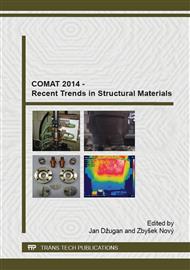p.67
p.73
p.79
p.85
p.91
p.99
p.107
p.113
p.121
New Type of Device for Achievement of Grain Refinement in Metal Strip
Abstract:
DRECE - Dual Rolls Equal Channel Extrusion" (dual rolls pressure combined with equal channel extrusion) method is used for production of metallic materials with very fine grain size (hereinafter referred to as UFG structure - Ultrafine Grain Size). During the actual forming process the principle of severe plastic deformation is used. The device is composed of the following main parts: “Nord” type gearbox, electric motor with frequency speed converter, multi-plate clutch, feed roller and pressure rollers with regulation of thrust, and of the forming tool itself – made of Dievar steel type. Metallic strip with dimensions 58×2×1000 mm (width x thickness x length) is inserted into the device. During the forming process the main cylinder in synergy with the pressure roller extrude the material through the forming tool without any change of cross section of the strip. In this way a significant refinement of grain is achieved by severe plastic deformation. This method is used for various types of metallic materials, non-ferrous metals and their alloys. Forming process is based on extrusion technology with zero reduction of thickness of the sheet metal with the ultimate aim - achieving a high degree of deformation in the formed material. The DRECE device is also being verified from the viewpoint of achievement of a UFG structure in a blank of circular cross-section (wire) with diameter of ø 8 mm × 1000 mm (length).
Info:
Periodical:
Pages:
91-97
Citation:
Online since:
October 2015
Keywords:
Price:
Сopyright:
© 2015 Trans Tech Publications Ltd. All Rights Reserved
Share:
Citation:


